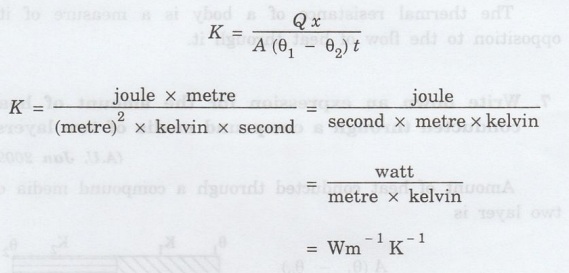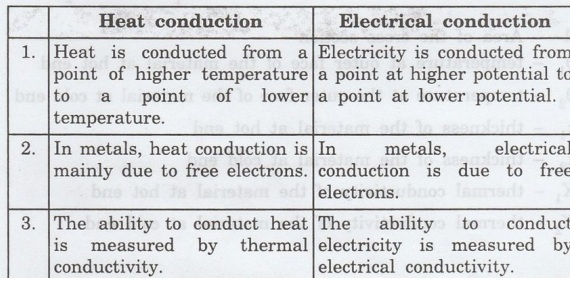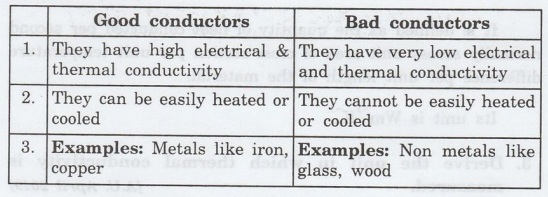Physics For Civil Engineering: Unit I: Thermal Application
Important Questions with Answers
Thermal Application | Physics For Civil Engineering
Physics For Civil Engineering: Unit I: Thermal Application: Questions And Answers
ANNA UNIVERSITY PART – A '2' Marks Q &
A
1.
Define heat conduction.
Conduction is the process
of transmission of heat from one point to another through substance (or some
medium) without the actual motion of the particles (atoms/ molecules) of the
substance.
2.
Define coefficient of thermal conductivity
and mention its unit.
It is defined as the quantity of heat
conducted per second normally across unit area of cross-section per unit temperature
difference per unit length of the material.
Its unit is Wm-1
K-1
3.
Derive the unit in which thermal conductivity is measured.
Thermal conductivity of
material

4.
How are heat conduction and electrical conduction analogous to each other?

Heat conduction
1. Heat is conducted from
a point of higher temperature to a point of
ower temperature.
2. In metals, heat
conduction is mainly due to free electrons.
3. The ability to conduct
heat is measured by thermal conductivity.
Electrical conduction
1. Electricity is
conducted from a point at higher potential to a point at lower potential.
2. In metals, electrical
conduction is due to free electrons.
3. The ability to conduct electricity
is measured by electrical conductivity.
5.
What are the characteristics of good and bad conductors?

Good conductors
1. They have high electrical & thermal
conductivity
2. They can be easily
heated or cooled
3. Examples: Metals like iron, copper
Bad conductors
They have very low
electrical and thermal conductivity
They cannot be easily
heated cooled
Examples: Non metals like
glass, wood
6.
What is thermal resistance?
The thermal resistance of
a body is a measure of its opposition to the flow of heat through it.
7.
Write down an expression for the amount of heat conducted through a compound
media of two layers.
Amount of heat conducted
through a compound media of two layer is

A - Area of the cross
section
θ1- temperature
at outer face of the material at hot end
θ2 -
temperature at the outer face of the material at cold end
x1 - thickness
of the material at hot end
x2 - thickness
of the material at cold end
K1 - thermal
conductivity of the material at hot end
K2- thermal
conductivity of the material at cold end
8.
Mention the methods to determine thermal conductivity of good and bad
conductors.
• Searle's method - for
good conductors like metallic rod
• Forbe's method - for
determining the absolute conductivity of metals
• Lee's disc method - for
poor conductors
• Radial flow method - for
bad conductors
9.
What are three modes of transferring heat?
• Conduction
• Convection
• Radiation
10.
Define convection.
It is the process in which
heat is transmitted from one place to another by the actual motion of the heated
particles.
11.
Define radiation.
It is the process in which
heat is transmitted from one place to the other directly, without the agency of
any material medium.
12.
Define fenestration.
It is defined as any
opening or arrangement of openings in a building (normally filled with
glazing).
13.
What are the various fenestration systems?
There are various
fenestration systems like glazing, windows, curtain walls, sloped glazing and
exterior doors.
14.
What are the three main components of fenestration?
1. Glazing
2. Framing
3. Shading devices and/or
screens
15.
What is the total heat transfer through fenestration?
The heat gain through
fenestration consists of two main components:
• Q thermal =
heat transfer between indoor and outdoor air. This is positive or negative
depending on temperature.
• Q solar
= heat transfer from solar radiation.
This is always a positive
number.
The total heat transfer
through fenestration
Qtotal = Qthermal
+ Qsolar
16.
What is thermal insulation?
• Thermal insulation is to
resist the he flow to I of heat to and ene mofrom a body. It is a material that
reduces the rate of heat flow.
• It is the reduction of
heat transfer (i.e the transfer of thermal energy between objects of differing
temperature) between objects in thermal contact or in range of radiative
influence.
17.
Mention a few methods of thermal insulation.
• Use of materials with
low conductivity
• Thickness of walls and
roofs
• Provision of spaces
• Heat insulation by
orientation
• Thermal insulation by
shading
• Providing sufficient
height of ceiling
• Using thermal insulating
materials
18.
What are the benefits of thermal insulation?
Due to thermal insulation,
the room remains cooler in summer and warmer in winter than outside. Hence a
room provided with thermal insulation gives comfort both in summer and winter.
etsed
Energy Saving: Due to
thermal insulation transfer of heat between inside and outside of the room is
restricted. This results in less quantity of energy required for maintaining
the desired temperature in the room.
19.
What is thermal performance of buildings?
It refers to the process
of modeling the energy transfer between building and its surroundings.
20.
What is thermal comfort?
It is the condition of
mind that expresses satisfaction with the thermal environment and it is
assessed by subjective evaluation. It is the occupants satisfaction with the
surrounding thermal conditions.
21.
What is the need for shading devices?
Well-designed sun control
and shading devices dramatically reduce building peak heat gain and cooling
requirements. These devices also improve the natural lighting quality of
building interiors.
22.
How are shading devices classified?
Shading devices are
classified into two types they are
(i) internal shading devices and
(ii) external shading
devices. gaiblind meinem
23.
What is central heating?
A central heating system
provides warmth to the whole interior of a building or portion of a building
from one point to multiple rooms.
24.
What are the components of central heating system?
• A gas supply lines, oil
tanks and supply lines or distinct heating supply lines.
• A boiler (or a heat
exchanger for district heating) whi heats water in the system.
• Pump to circulate the
water in the closed system.
• Radiators which are wall-mounted
panels through which the heated water passes in order to release heat into rooms.
Anna University Part B '16' Marks
Questions
1. Derive an expression for the quantity
of heat flow through a metal slab whose faces are kept at two different
temperatures.
2. Describe with relevant theory the
method of determining the coefficient of thermal conductivity of a rubber tube.
3. Describe method to determine thermal
conductivity of powder material.
4. Discuss heat transfer through fenestration.
5. Describe methods of thermal
insulation.
6. Explain heat gain and loss estimation
in the components of buildings.
7. Discuss the factors affecting thermal
performance of buildings.
8. Describe thermal measurements in
buildings.
9. Explain thermal comfort and indices
of thermal comfort.
10. Describe climate and design of solar
radiation.
11. Discuss the different types of
shading devices. lqislum
12. Explain central heating system.
Physics For Civil Engineering: Unit I: Thermal Application : Tag: : Thermal Application | Physics For Civil Engineering - Important Questions with Answers
Related Topics
Related Subjects
Physics for Civil Engineering
PH3201 2021 Regulation | 2nd Semester Civil Dept 2021 Regulation
